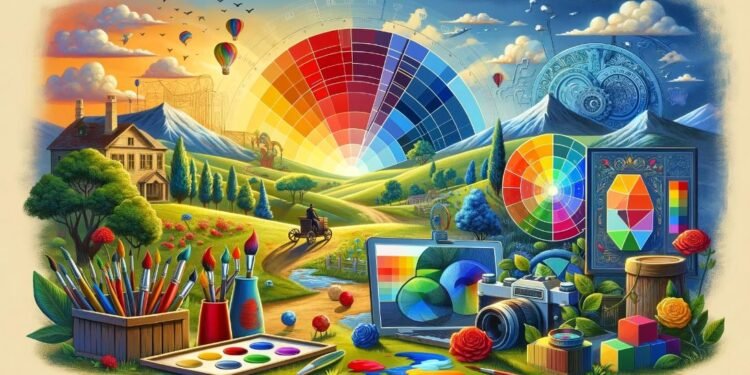Last Updated on November 23, 2023 by admin
Introduction
Primary colors are the cornerstone of color theory and essential to visual arts, design, and everyday life. These colors, typically identified as red, blue, and yellow, are fundamental because they cannot be created through a mixture of other colors. They form the basis from which various combinations and intensities derive a wide range of hues and shades. This article delves into the intricacies of primary colors, exploring their significance, applications, and the science behind their perception.
The Basics of Primary Colors
At the core of understanding primary colors is their role in color theory. In traditional color theory, red, blue, and yellow are primary colors. This theory posits that these colors are unique in their ability to mix and create secondary and tertiary colors. Secondary colors, such as orange, green, and purple, are formed by mixing two primary colors. Further mixing of primary and secondary colors yields a range of tertiary colors. This basic understanding of color mixing is fundamental in fields ranging from art and design to printing and digital media.
Primary Colors in Art and Design
In art and design, primary colors hold a place of great importance. Artists have long used these colors to convey emotions, create depth, and build a visual narrative. Primary colors in art can be traced back to ancient times, and their application has evolved significantly over the centuries. In modern art, primary colors are often used for their boldness and ability to stand out, making a statement in both abstract and figurative art forms. These colors are used strategically in graphic design to create visually appealing and practical strategies. The choice of primary colors can significantly influence a design’s mood, tone, and overall impact.
Primary Colors in the Digital World
In the digital world, the concept of primary colors takes a slightly different turn. The primary colors of light, red, green, and blue (RGB), are the basis of color representation in digital screens, including TVs, computers, and smartphones. This RGB color model is additive, meaning the colors are created by blending light. Combining these colors in various intensities produces the broad spectrum of colors we see on digital screens. Understanding this color model is crucial for digital artists, web designers, and anyone creating visual content for screens.
The Science Behind Color Perception
The way we perceive primary colors is deeply rooted in the science of light and human biology. The human eye perceives color through photoreceptor cells called cones, of which there are three types, each sensitive to different wavelengths of light: red, green, and blue. This trichromatic vision is why the RGB color model is so effective in digital media. When light hits an object, some wavelengths are absorbed while others are reflected, and the reflected light determines the color we perceive. This phenomenon explains why primary colors appear distinct, and their combinations produce various other hues.
Cultural Significance of Primary Colors
Primary colors also hold significant cultural and psychological meanings. Different cultures have attributed various symbolisms to these colors throughout history. For example, red represents passion, danger, or power, while blue symbolizes tranquility, trust, or sadness. Yellow, on the other hand, is frequently associated with happiness, energy, or caution. These cultural associations play a crucial role in art, design, marketing, and everyday decision-making, influencing how people react to different colors and combinations.
Primary Colors in Education
In educational settings, primary colors are a fundamental concept taught to children at an early age. Understanding these colors and how they mix to create other colors is essential for artistic endeavors and developing cognitive skills and color recognition. Educators use various tools and activities, such as color wheels, painting exercises, and interactive games, to teach children about primary colors and the basics of color theory. This foundational knowledge is crucial in nurturing creativity and visual literacy from a young age.
Challenges and Controversies
Despite their apparent simplicity, primary colors are subject to various challenges and controversies, particularly regarding their definition and application. For instance, some color theories propose different sets of primary colors, such as cyan, magenta, and yellow, in the CMYK color model used in printing. Additionally, the perception of color can be subjective and influenced by factors like lighting, context, and individual differences in vision. These complexities add layers to understanding primary colors and their application in various fields.
Conclusion
Primary colors are pivotal in various aspects of life, from art and design to technology and education. Their fundamental nature and the vast range of hues they produce make them a perpetual subject of fascination and study. As we advance in technology and understanding of color science, the application and significance of primary colors will likely evolve, continuing to influence and inspire in countless ways. Whether in a painter’s palette, a designer’s toolkit, or a child’s crayon box, primary colors remain at the heart of our colorful world.
Also, Read Understanding Conversion from Inches to Millimeters: A Comprehensive Guide.










